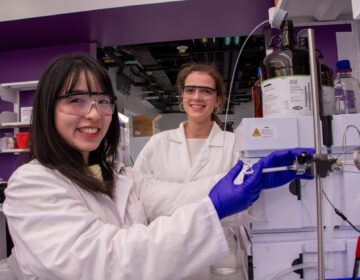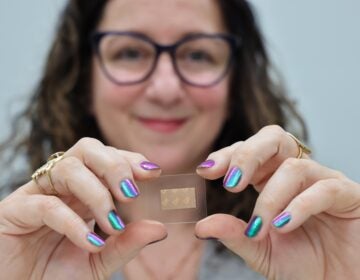From med spas to DIY: Botox is everywhere but not without risks
For a product whose toxic origins trace back to a biological weapons lab in Maryland, Botox has helped normalize cosmetic injectables
Listen 12:43This story is from The Pulse, a weekly health and science podcast.
Find it on Apple Podcasts, Spotify, or wherever you get your podcasts.
When it comes to beauty and cosmetics, the internet is full of conflicting tips, tricks, and suggestions — even suspicions. So when one day over breakfast, a plastic surgeon hinted that some of the more conspiratorially-minded online cosmetic hobbyists were onto something, I just let him talk.
The surgeon, whom I spoke with on background for another story, mentioned an “open secret” among some of his peers: diluted Botox. It was a real moneymaker for injectors willing to stoop that low, he said, and a real pain for those seeking lasting results. Reduced potency meant providers could save product, save money, and keep patients coming back for treatments more often.
It was the perfect scheme and I was determined to nail down the story.
Our breakfast ended with a promise to follow up. When I did, it wasn’t long before this doctor stopped returning my calls. He seemed to get cold feet.
So I started asking around. I wanted to know if this practice was really a thing, and if so, how it came to this and where Botox might be heading.
Kevin Duplechain, president of the American Academy of Cosmetic Surgery, told me he wasn’t personally aware of anyone diluting Botox, but he said it would be easy to do.
“I’m not suggesting that anyone does this, but this is how it could happen. You get a vial of Botox, and you’re supposed to put in two cc’s of bacteriostatic water, which is kind of what’s recommended to dilute the product and create a certain concentration,” Duplechain said.
“Well, somebody decides they want to put in double the amount of water in the product and inject that. I mean, who’s gonna know differently, right? And so certainly, that’s a way to increase your profit. ”
Duplechain said the consumer would have no idea. “You’re very vulnerable.”
This sense of consumer vulnerability kept coming up in the conversations I had about Botox and the many other cosmetic injectables that followed.
From the moment Botox was approved as a skin care treatment by the Food and Drug Administration in 2002, the market for it has only grown. Even following the pandemic, sales of Botox have soared among young people as plastic surgeons report the “Zoom boom” has doubled business.
For a product whose toxic origins trace back to a biological weapons lab in Maryland, Botox has helped normalize cosmetic injectables — thanks, in part, to the product’s ubiquity in popular culture.
“Back in the early 2000s, folks would go in the back door, they would come out the back door was they didn’t even want to know,” said Alex Thiersch, CEO of American Med Spa Association. “Now, you’ve got things like you had “The Real Housewives,” you had “Sex in the City,” you’ve got “The Kardashians,” they are doing these treatments, on camera, on Instagram, on YouTube, Tiktok, whatever it is and so the treatments themselves are becoming much more normalized.”
Botox almost immediately slipped out of the confines of the doctor’s office into all kinds of settings. But early adopters relied on professionals like Kevin Duplechain for their fix, and Duplechain was happy to oblige. He said Botox was central to his practice and is still integral for growth.
“You know frankly, I think it’s everything. I really do,” Duplechain said.
Subscribe to The Pulse
When Kevin started administering Botox to his patients in the mid-90s, he encouraged first timers to bring a friend. He bought Botox in 100 unit vials that had a four hour shelf life once opened. More customers meant reduced waste and cheaper prices.
It also helped spread the word about what Botox could do, a practice encouraged by Allergan, the maker of Botox.
“[Allergan] frankly, did an incredible job of teaching us how to grow these practices and making it available to people,” Duplechain said.
Eventually, expanding Botox’s reach meant making it available in more places and folding it into new business models. Allergan provided training and educational resources not just to dermatologists and plastic surgeons, but to providers like Francis and Colleen Acunzo, who in the 1990s, revolutionized the beauty industry.
“We thought spas could change lives,” said Francis Acunzo.
Back then, the married couple owned and operated two beauty spas in Boston (think facials and massages). One day, they read about a laser that could remove age spots from the skin in the Sunday paper.
“And we’re like, oh, this doesn’t belong in a dermatology office, it belongs in a spa,” said Francis Acunzo.
They had longed dreamt of finding new ways to innovate and they believed this laser could help turbo-charged their spas and offer high-tech options for its clients. They took the idea to the company that made the laser, merged their companies, and a new concept was born: the medical spa.
When Botox hit the market, the Acunzos were all over it. And they’ve never looked back.
“At this point, I actually have to work hard to find locations that have less than 60% of their business being done with injectables,” said Francis Acunzo.
The medical spa industry is now worth $15 billion with an estimated 9,000 spas in operation in the U.S. today. The Acuznos helped take Botox, and other cosmetic injectables like it, out of the medical realm into a more relaxed setting.
“These medical spas have positioned themselves much more like a very cool either spa or salon,” said Alex Thiersch. “So it’s it doesn’t feel like a doctor’s office, there’s a much more kind of fashionable and flashy and sexy appeal to going in to these places and getting work done as opposed to going to a very sterile and clinical doctor’s office. But what’s happened with that is that it does give the impression to a lot of people that it’s kind of an easy, pseudo medical procedure that you’re going in to get.”
Thiersch told me the beginning of the Botox boom for medical spas was a bit like the Wild West.
“There was tons of people out there making millions of dollars running these very, very cool, innovative practices, med spas, that were making a very good living, but they were all non-compliant,” Thiersch said.
There were often issues with how products were being stored, who performed injections, and what kind of training they had. The rules and regulations were confusing. Luckily for those medical spas, nobody seemed to be very concerned at the time — or watching too closely.
“The enforcement mechanism for this industry is controlled by each individual state by the Medical Board of the nursing board in that particular state,” he said. “Enforcement is pretty lackadaisical in this industry because there just isn’t enough resources on the state level to really police what’s going on.”
But Thiersch says things have begun to change. More and more investigations are happening every year as horrified customers share bad experiences online.
I spoke to one woman, who wanted to stay anonymous for privacy concerns, turned to Yelp after her search for reasonably priced Botox led her to a random office park in Cherry Hill, New Jersey. She started getting Botox years ago after a comment from her boss.
“He said, ‘Don’t you see how people look at you. You have a very severe face.’”
The injections made her feel more confident. But after moving for work, she had to find a new provider. That’s when she stumbled upon a Groupon online that gave her the name and address for a doctor with cheap prices who administered Botox in Cherry Hill a few times a year.
When she arrived, others were sitting around in a conference room waiting to see this doctor.
“There was nothing medical in there,” she told me. The doctor treated patients behind a curtain. “I heard people in the conference room saying, oh, this is the cheapest you’ll ever find.”
Eventually, her name was called behind the curtain. The doctor pulled something out of a duffel bag. She asked how he was able to provide Botox so inexpensively.
“He said, ‘Oh I buy in bulk, a lot of bulk.’ But he doesn’t tell you what he’s buying or what he’s giving you.”
She was concerned, but she was already there. And he was a doctor after all — one with a large clientele. So she went with it.
“It all goes by so fast. He would never actually say what the price is or how many units you’re getting. And there was no receipt,” she said.
She didn’t experience any adverse side effects, but she thought about reporting this doctor. Eventually others did, but not before one of his patients was hospitalized after being injected with unknown fillers. The doctor’s license was suspended.
This choice between legitimacy and price is not uncommon for those seeking Botox, and other injectables, for the first time.
Summer Rae Leach first seriously thought about getting Botox when she was working on a photoshoot in Florida.
“One of the models who was a little bit older than me, she said that she was having a botox party at her house,” Leach said.
There would be wine, little meatballs, even a dog. And, of course, discounted Botox. She decided to go.
“The person that was giving the Botox there was super nice, super professional. We all filled out kind of like a waiver before we started — just to make sure that, you know, if anything happens, things like that.” she said. “So all of the safety precautions were there. And she was, of course, a professional. So she did work in an office, but this was kind of something that she did on the side was hosting parties. And so it was such a good experience.”
Leach liked the casual vibe with the promise of a professional injecting the Botox. It’s what convinced her to get Botox in the first place. But she has since come to suspect that the Botox she got at that party was diluted — the results didn’t last nearly as long as injections she later got in other places.
So why run the risk of getting diluted Botox, or being in a space that makes you feel uncomfortable, when it is now possible to take matters into your own hands?
It may sound like a question with a potentially dangerous answer, but as I learned, many have started asking it anyway.
A quick search online reveals a thriving market for illegal foreign injectables in the U.S. These products are not FDA-approved and are astonishingly easy to purchase — no health care license, business license, or prescription needed.
Do-it-yourself tutorials have racked up thousands of views on Youtube as influencers peddle coupon codes for online stores with global shipping. There, one can buy syringes, dermal fillers, Korean botox, and even lidocaine – a powerful anesthetic. Some of these companies have products available for purchase on Amazon.
When asked for information, the FDA did not have any data to share about the sale of these products in the United States. Neither did the Drug Enforcement Administration.
So I tried to talk to influencers fueling this market, and the people who injected themselves with foreign Botox-like products. Many did not want to talk. One influencer told me they were afraid of being deplatformed. Others told me the attention might make it harder for them to get their hands on these products in the future.
Why pay $500 for a treatment that may be diluted when you could [do] it at home for $50 yourself, one wrote to me.
Every medical professional I spoke with warned about the potentially permanent, perhaps even fatal, consequences of do-it-yourself cosmetic procedures at home. But as the pressure to look younger continues to grow, its hard to imagine a safe, reliable, and relatively inexpensive alternative will emerge anytime soon.
WHYY is your source for fact-based, in-depth journalism and information. As a nonprofit organization, we rely on financial support from readers like you. Please give today.







